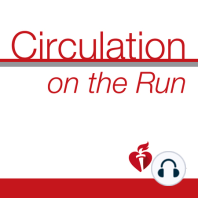16 min listen
Circulation January 22, 2019 Issue
ratings:
Length:
25 minutes
Released:
Jan 21, 2019
Format:
Podcast episode
Description
Dr Carolyn Lam: Welcome to Circulation on the Run, your weekly podcast summary and backstage pass to the journal and it's editors. We're your co-hosts of Circulation on the Run and if you don't know what this show is about, well, you have to listen to the previous episodes in January please. I'm Dr Carolyn Lam, associate editor from the National Heart Center and Duke National University of Singapore. Greg Hundley: I'm Greg Hundley from the Pauley Heart Center at VCU Health in Richmond, Virginia. Dr Carolyn Lam: So Greg, before we pick up our coffees and begin discussing a couple of the paper, let's just tell everyone that this feature paper, they have to listen to because it is the results of the cardiac amyloidosis section, or sub-set of the APOLLO study. Have to listen to this one. But how about the other papers in today's issue Greg? Greg Hundley: Right Carolyn, the first one I'm going to start with is from Alexander Fanaroff at Duke University and the DCRI. And basically, this particular paper was looking at the procedural volume and how that might affect outcomes with those that are performing PCI. So they divided the cohort into those individuals that had less than 50 PCIs per year, 50 to 100 and then greater than 100 PCIs per year. So, this is looking at our national cardiovascular data registry within the United States, and of course, as you know, that's linked to Medicare claims data for those that are over 65 years in age. So they had 723,644 PCIs performed by 8,936 operators. And the surprise in this study was that those low volume operators, less than 50 PCIs per year had a one year rate of 15.9% of MACE as opposed to those that were high volume operators that had 16.9% MACE rates. That was significant at a P value of .004. Dr Carolyn Lam: Wait a minute, this seems different from prior reports. Are you saying that those with low volume operators actually had lower mortality? Greg Hundley: Yeah, exactly. And you've pointed out something, cause previously what's been shown is that high volume operators have lower 30 day and in-hospital mortality rates. And that was actually confirmed in this study. But out of a year it was really the low volume operators in unadjusted results had lower rates of all MACE. A very nice editorial by Dharam Kumbhani from UT Southwestern points out that high volume operators do tend to take on more serious cases, those with higher numbers of cardiovascular risk factors. And so, when they did adjustments and accounted for all those risk factors, actually the event rates were the same. Still though, they're the same. And so what could be going on? And the editorialist and also the authors of the paper point out, "Hey, maybe we shouldn't just be focusing on PCI volume per operator, but other quality metrics to look at outcomes. And so this really builds in to the whole quality discussion. Adherence to therapy with the patients in your health care system. What about operator longevity? An operator that may have been doing this for 10 years but has a lower volume, maybe that could come into play. So future studies I think, certainly all over the world in this field, this paper's going to direct us to focus more on other quality issues and not just procedural volume. Dr Carolyn Lam: So, quality versus quantity. Interesting. Well switching gears to a paper that I thought was nice, it is from Dr Lubitz from Massachusetts General Hospital in Boston and colleagues, and they sought to answer the question of whether refining a phenotypic classification of heart failure would facilitate genetic discovery. So, to do that, they defined all cause heart failure among almost 500,000 participants in the UK bio-bank and performed a GWAS study and then later refined the heart failure phenotype by classifying individuals with left ventricular dysfunction but without coronary artery disease as having nonische
Released:
Jan 21, 2019
Format:
Podcast episode
Titles in the series (100)
Circulation August 30, 2016 Issue: Circulation Weekly: Your Weekly Summary & Backstage Pass To The Journal by Circulation on the Run
